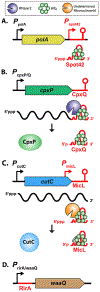New aspects of RNA-based regulation by Hfq and its partner sRNAs
- PMID: 29125938
- PMCID: PMC10367044
- DOI: 10.1016/j.mib.2017.10.014
New aspects of RNA-based regulation by Hfq and its partner sRNAs
Abstract
Hfq, an RNA chaperone, promotes the pairing of small RNAs (sRNAs) to target mRNAs, mediating post-transcriptional regulation of mRNA stability and translation. This regulation contributes to bacterial adaptation during stress and pathogenesis. Recent advances in sequencing techniques demonstrate the presence of sRNAs encoded not only in intergenic regions but also from the 3' and 5' UTRs of mRNAs, expanding sRNA regulatory networks. Additional layers of regulation by Hfq and its associated RNAs continue to be found. Newly identified RNA sponges modulate the activity of some sRNAs. A subset of sRNAs are proving to be bifunctional, able to pair with targets and also encoding small ORFs or binding other RNA binding proteins, such as CsrA. In addition, there are accumulating examples of Hfq inhibiting mRNA translation in the absence of sRNAs.
Published by Elsevier Ltd.
Figures





Similar articles
-
CsrA regulation via binding to the base-pairing small RNA Spot 42.Mol Microbiol. 2022 Jan;117(1):32-53. doi: 10.1111/mmi.14769. Epub 2021 Jul 7. Mol Microbiol. 2022. PMID: 34107125 Free PMC article.
-
Competition among Hfq-binding small RNAs in Escherichia coli.Mol Microbiol. 2011 Dec;82(6):1545-62. doi: 10.1111/j.1365-2958.2011.07907.x. Epub 2011 Nov 20. Mol Microbiol. 2011. PMID: 22040174 Free PMC article.
-
Dynamic interactions between the RNA chaperone Hfq, small regulatory RNAs, and mRNAs in live bacterial cells.Elife. 2021 Feb 22;10:e64207. doi: 10.7554/eLife.64207. Elife. 2021. PMID: 33616037 Free PMC article.
-
Regulation of Transcription Termination of Small RNAs and by Small RNAs: Molecular Mechanisms and Biological Functions.Front Cell Infect Microbiol. 2019 Jun 12;9:201. doi: 10.3389/fcimb.2019.00201. eCollection 2019. Front Cell Infect Microbiol. 2019. PMID: 31249814 Free PMC article. Review.
-
Structure and RNA-binding properties of the bacterial LSm protein Hfq.RNA Biol. 2013 Apr;10(4):610-8. doi: 10.4161/rna.24201. Epub 2013 Mar 27. RNA Biol. 2013. PMID: 23535768 Free PMC article. Review.
Cited by
-
An RNA-centric global view of Clostridioides difficile reveals broad activity of Hfq in a clinically important gram-positive bacterium.Proc Natl Acad Sci U S A. 2021 Jun 22;118(25):e2103579118. doi: 10.1073/pnas.2103579118. Proc Natl Acad Sci U S A. 2021. PMID: 34131082 Free PMC article.
-
Gene autoregulation by 3' UTR-derived bacterial small RNAs.Elife. 2020 Aug 3;9:e58836. doi: 10.7554/eLife.58836. Elife. 2020. PMID: 32744240 Free PMC article.
-
SraL sRNA interaction regulates the terminator by preventing premature transcription termination of rho mRNA.Proc Natl Acad Sci U S A. 2019 Feb 19;116(8):3042-3051. doi: 10.1073/pnas.1811589116. Epub 2019 Feb 4. Proc Natl Acad Sci U S A. 2019. PMID: 30718400 Free PMC article.
-
Spatio-temporal organization of the E. coli chromosome from base to cellular length scales.EcoSal Plus. 2024 Dec 12;12(1):eesp00012022. doi: 10.1128/ecosalplus.esp-0001-2022. Epub 2024 Jun 12. EcoSal Plus. 2024. PMID: 38864557 Free PMC article. Review.
-
Proteins That Chaperone RNA Regulation.Microbiol Spectr. 2018 Jul;6(4):10.1128/microbiolspec.rwr-0026-2018. doi: 10.1128/microbiolspec.RWR-0026-2018. Microbiol Spectr. 2018. PMID: 30051798 Free PMC article. Review.
References
Publication types
MeSH terms
Substances
Grants and funding
LinkOut - more resources
Full Text Sources
Other Literature Sources
Molecular Biology Databases

